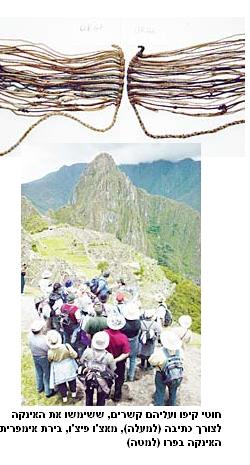News agencies, Haaretz, Walla News

Three knots in the shape of the number 8 may be the first word discovered in the Inca language in hundreds of years. The Inca Empire flourished in the western part of South America in the 15th century and disappeared with the arrival of the Spanish conquistadors in the early 16th century.
Until recently, scholars thought that the empire left behind nothing that could be defined in modern terms as writing. However, her sons left threads called "kipo", with knots in different colors and patterns on them, which were considered a mystery to historians and anthropologists.
Most of the connections turned out to be a means of accounting, but understanding them was difficult and complicated. Gary Arton and Kari Nerezain of Harvard University claim to have found a repeating pattern of a triple bond in some threads. In their opinion, this example marks the name of the ancient city of Porochoco, about 11 km north of Lima, the capital of Peru.
The two researchers reported their findings in Friday's edition of
Science journal. They analyzed with the help of a computer 21 kifu wires. It seems that one group of kifu was intended for local use, and the others were used to report to external authorities what was happening there, or to receive instructions from the authorities.
"We assume that every kippo that was passed down as part of the administration of the Inca kingdom, which includes three knots arranged in the figure of eight, would have been identified by the administrative personnel as a bill from the palace in Poruchoco," the researchers said. This arrangement of connections," Arton said. According to the researchers, identifying a place name can lead to a first step in deciphering the method of connections. "This is the first time that it is possible to identify in the connections the transfer of information that was of interest to the state," said Erton. Today, museums display between 8 and 650 kipou. In two-thirds of them the connections are arranged in a decimal system which implies use for account management needs. In the rest of the Kipo, other connections appear, which are apparently a type of written language.
"We believe that these are fictional texts," said Arton, who added that "the identification of these connections may not be numerical. If numerals are used to indicate quantities and the like, we may be able to use them to identify different objects that have been counted." If the researchers are able to identify such words, it will be possible to search for them in the verbatim as well. Some reports from the period of the Spanish occupation indicate that the Incas told the Spaniards that the circle was intended for historical recording. The Spaniards recorded some of the stories, but destroyed most of the kippo.
Glenn Brokaw, a professor of languages at the University of Buffalo, called the article "remarkable", because Arton was able to prove the connection between three levels of "kipo". "Each level concentrates certain information related to the level below it," Brokaw said. "This explained to us how Kifu was used within the administration. The discovery may seem insignificant to those who are not involved in the subject, but within the framework of Kipo studies, this is a very significant discovery."
History connoisseur - the New World until Columbus
https://www.hayadan.org.il/BuildaGate4/general2/data_card.php?Cat=~~~249786038~~~162&SiteName=hayadan
